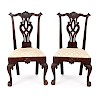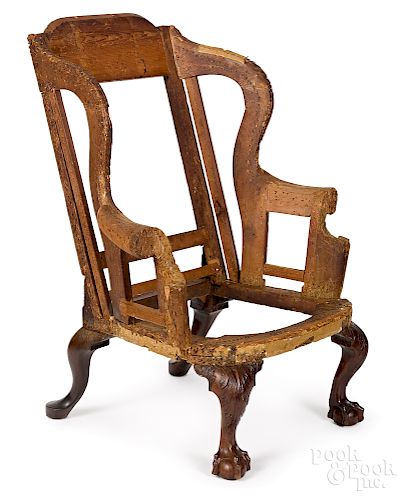CALL US TODAY: (610) 269-4040 - FAX: (610) 269-9274
Important Philadelphia Chippendale easy chair
Bid Increments
| Price | Bid Increment |
|---|---|
| $0 | $25 |
| $500 | $50 |
| $1,000 | $100 |
| $2,000 | $200 |
| $5,000 | $500 |
| $10,000 | $1,000 |
| $20,000 | $2,000 |
| $50,000 | $5,000 |
| $100,000 | $10,000 |
| $200,000 | $20,000 |
| $500,000 | $50,000 |
Condition
Pook & Pook, Inc. does not offer in-house packing or shipping, but we are happy to assist buyers in coordinating shipping with an outside shipping company. Listed below are the companies that typically ship for our customers, but you are welcome to use a shipper of your own choosing. If you have questions prior to purchase, please email the shipper well in advance of the auction. Be sure to include the sale date, lot number, description and estimate with all correspondence. How the shipping process works once you have purchased an item at Pook & Pook: 1. You contact one or more of the shippers listed below (or a shipper of your own choosing) to obtain competitive quotes. Be sure to provide the shipper with the following information: Your name, lot#(s) purchased, invoice total, insurance required, and the address to which the items are being shipped. Please note that most shippers cannot generate a quote until after an item is purchased, but they can give you an estimate. Once you choose a shipper, let them know you would like them to ship your purchase. 2. You must then contact Pook & Pook, Inc. and let us know which shipper you would like to use (email shipping@pookandpook.com or call (610) 269-4040). 3. Items are then picked up at Pook & Pook, Inc.’s auction house by the shipper. If you are utilizing a shipper for smaller items, we have pick-up times scheduled at least once a week following each auction (i.e. The UPS Store typically comes every Friday), but if necessary, special pick-up times can be arranged if your require your items immediately (please note that there will be additional charges for special pick-up times). For larger items, please have the shipper call us to arrange a pick-up time. Shippers can pick up items at our auction hall between 9AM and 4:30PM Monday through Friday. All items must be picked up, or shipping arrangements made within two weeks of the day of sale. Any items left at our facility for more than two weeks following the sale will incur storage fees at a rate of $5.00 per lot per day (this rate applies to all items regardless of size or value). 4. Once the shipper has your items, please allow 3-5 business days for them to process and package your purchase. If payment for shipping has not yet been made, the shipper will contact you to arrange payment and then ship your items. 5. Please note that full payment for your items must be received before we will turn your item(s) over to the shipper. Please also note that if you pay with a personal check or international money order/cashier’s check, your items will be given a release date of 10 days after your payment is deposited. This date is supplied to the shipper and they cannot ship your item(s) until after that date unless you provide Pook & Pook, Inc. with a copy of your bank statement showing that the check has cleared your account (we cannot check this from our bank). For shipment of small items the following shippers have offered their services: 1. The Packaging Store in Lansdale, PA (hello@packandshipnow.com, phone: (215) 361-6940 or fax: (215) 361-6941) 2. The UPS Store in Downingtown, PA (store3093@theupsstore.com, phone: (610) 518-5010, ), fax: (610) 518-5476), contact: Bruce Cobb (if choosing this shipping option, please specify The Downingtown UPS Store) For shipment of large items the following shippers have offered their services: 1. Craters and Freighters in Plymouth Meeting, PA (philly@cratersandfreighters.com or (610) 397-0488) or (866) 397-0488) Area: entire US and abroad 2. Mt. Everest Moving Company in Ephrata, PA, (EverestMoving@gmail.com or (717) 314-7647) Contact: Conrad Martin
















